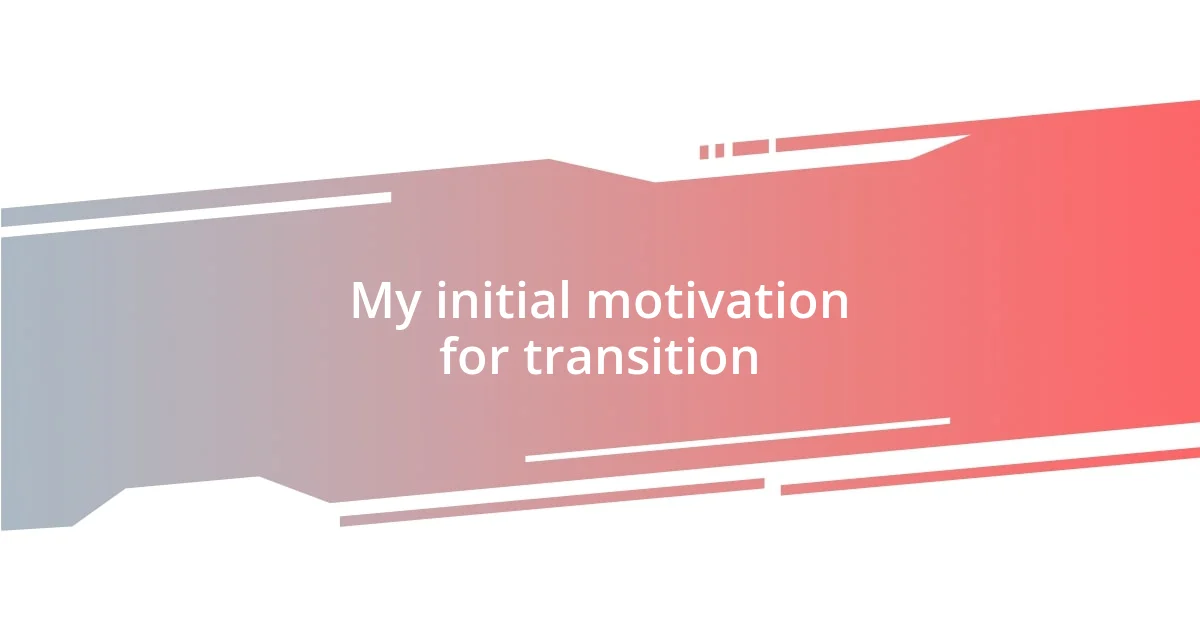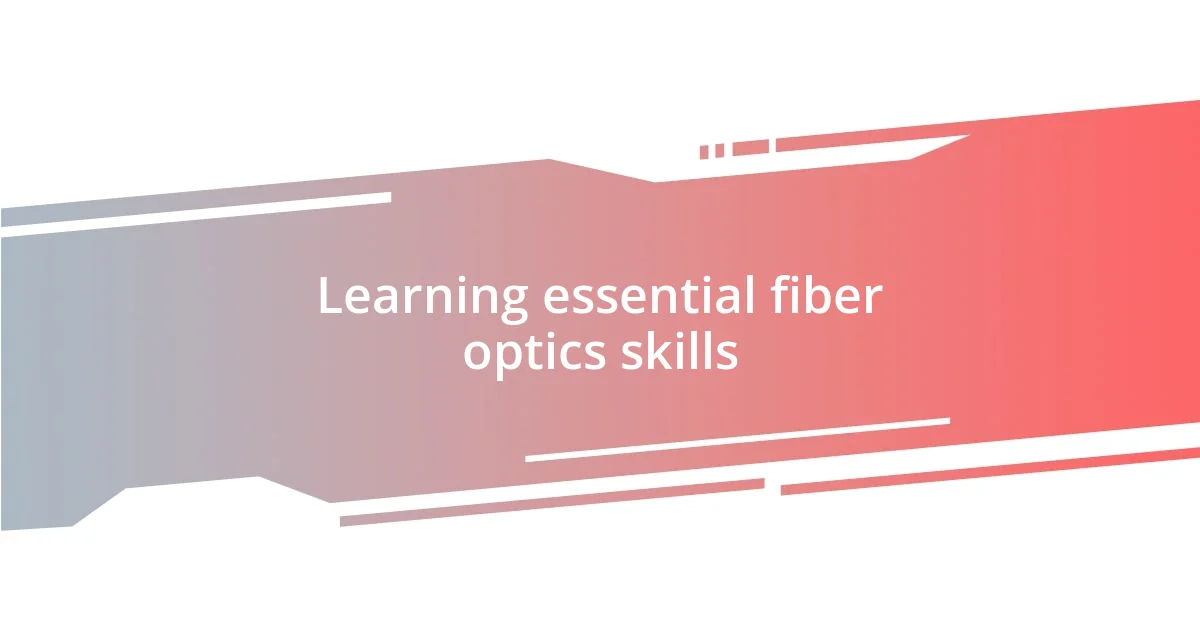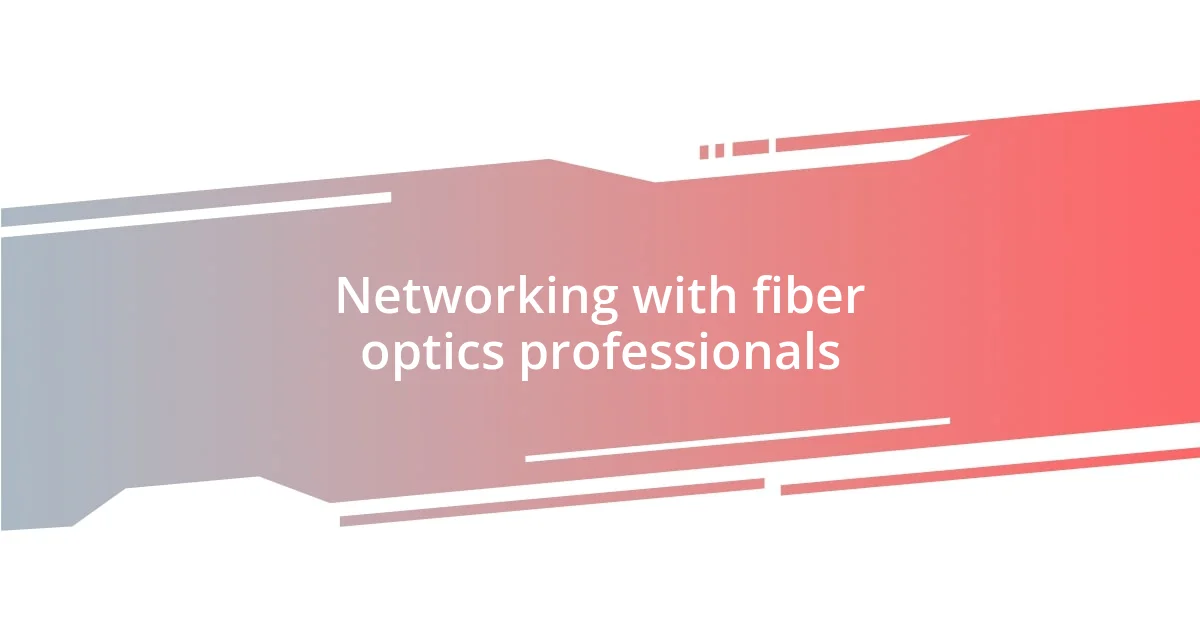Key takeaways:
- Understanding the basics of fiber optics and its significance in global communication fosters a sense of wonder and interconnection.
- Hands-on experiences, such as crimping connectors and troubleshooting, are essential for building practical skills and confidence in the fiber optics field.
- Networking with industry professionals fosters mentorship opportunities and collaborative growth, enhancing learning and understanding of challenges in fiber optics.

Understanding fiber optics basics
Fiber optics is all about transmitting data through light, and honestly, the moment I grasped this concept, it felt like unlocking a whole new world. I remember my first day learning about total internal reflection—can you believe that this phenomenon allows light to travel long distances without losing its quality?
As I dove deeper into the basics, I became fascinated by the way fibers are made of glass or plastic, ingeniously designed to guide light. At first, I couldn’t wrap my mind around how tiny strands could carry vast amounts of information. But that’s the beauty of fiber optics; the design is so efficient that it can beat traditional copper wiring in speed and capacity. Isn’t it amazing how we can send countless movies at once across the globe through these thin fibers?
What really struck me was learning about the core and cladding of a fiber optic cable, which work together to keep light contained. This reminded me of teamwork—how different roles can create something greater than the sum of their parts. When I visualize these components working in harmony to connect people worldwide, it sparks a sense of wonder in me. Have you ever thought about how interconnected our world truly is? Fiber optics is a key player in making that happen.

My initial motivation for transition
My leap into the world of fiber optics was driven by a blend of curiosity and a desire to embrace the cutting-edge technology rapidly reshaping our connectivity. I still vividly recall standing in a seminar, overwhelmed yet excited, as the speaker unveiled how fiber optics could change everyday communication. This realization sparked a fire in me—a blend of passion and purpose.
- I wanted to be part of something transformative.
- I was eager to contribute to building a faster, more efficient communication infrastructure.
- The thought of working on technology that connects families across continents thrilled me.
- I felt a personal connection to an industry that impacts lives daily.
The potential seemed endless, and I was ready to learn, innovate, and evolve. I wanted my skills to align with the demands of a digital age, where every second counts and efficiency reigns supreme.

Learning essential fiber optics skills
Learning the essential skills for fiber optics isn’t just about grasping the theory; it’s about immersing yourself in practical experiences. I’ll never forget the first time I crimped fiber connectors—my hands were shaky, and I felt a mixture of anxiety and excitement. As I finally got it right, the satisfaction that washed over me was incredible. It was a tangible step into the real-world applications of what I had learned, and it solidified my confidence in my abilities.
Over time, I realized that mastering skills like fusion splicing and testing cable performance is crucial for anyone in the field. Each task felt like a mini-adventure with its unique challenges. For instance, working with a splicing machine for the first time was intimidating, but as I became more familiar with the technique, I found a rhythm and precision that surprisingly felt meditative. Have you ever experienced a skill transition like that? The sense of accomplishment can be quite empowering.
As I navigated this learning curve, I recognized the importance of staying updated with industry standards and best practices. Attending workshops and observing specialists encouraged my growth immensely. I often caught myself taking notes not just on the technical side but also on how these experts communicated with each other. Communication is key in this field, whether it’s with colleagues or clients, and I’ve learned it’s as vital to the job as the technical skills themselves.
| Skill | Description |
|---|---|
| Crimping Connectors | For connecting fibers to equipment; a practical introduction to hands-on work. |
| Fusion Splicing | Joining two fiber ends efficiently; requires precision and patience. |
| Cable Testing | Ensuring signal quality and performance; critical for delivering reliable service. |

Hands-on projects for practice
Getting hands-on experience with fiber optics is where the magic truly happens. One of my memorable projects was assembling a simple fiber optic network in a small lab setting. I remember my initial struggle with unraveling cables, battling knots as I attempted to lay them out without any twists. But once I got it all together, watching that first light pulse travel through the fiber was like igniting a personal spark—a visual representation of my hard work. Have you ever felt that rush when everything finally clicks? It’s quite a thrilling experience.
I also took on a project to test and troubleshoot existing fiber links. Initially, the daunting task of interpreting waveform patterns felt abstract, almost like reading a foreign language. Yet, as I began to draw connections between what I studied and what my tools were showing me, the operations became clearer. Those moments of clarity not only built my confidence; they showed me how important it is to understand the nuances of your tools. Does it not feel rewarding when those once-confusing concepts begin to reveal their secrets?
Another project involved collaborating with peers on a mock installation. I distinctly remember the debates we had over optimal routing paths—everyone had their input, and sometimes we disagreed. But that collaborative problem-solving felt enriching, as we combined our unique perspectives to achieve our goal. Ultimately, it wasn’t just about laying fiber; it fostered an environment that mirrored real-world scenarios where communication and teamwork make all the difference. These experiences taught me that each challenge we face can transform into an opportunity for growth.

Overcoming challenges during transition
Transitioning to fiber optics came with its fair share of hurdles, but each challenge offered an opportunity for growth. When I first attempted to troubleshoot a device that wasn’t performing, I paled at the thought of my failed attempts. However, I learned to break down the problem systematically, asking myself critical questions: What did I miss? Is there a simple issue? With each resolved problem, I gained confidence, transforming frustration into skills that felt empowering.
One memorable moment was trying to understand the intricacies of network topologies. I had to rely heavily on diagrams and theoretical concepts initially, and it felt overwhelming. But once I started visualizing connections using physical cables and real equipment, everything fell into place. It reminded me of solving a puzzle where the pieces finally clicked together. Have you ever felt that sense of euphoria when everything starts to make sense? For me, those moments were not just learning milestones; they were affirmations of my ability to navigate a tough field.
Collaboration also played a significant role in overcoming obstacles. Working on projects with more experienced colleagues sometimes felt intimidating but profoundly rewarding. During one instance, their shared knowledge helped me understand complex configurations that initially seemed insurmountable. I often found myself marveling at how different perspectives can illuminate a shared goal. It became clear that while individual skills are important, the power of teamwork can often bring clarity and innovation where challenges reside. Isn’t it fascinating how collaboration can lead to breakthroughs that we could never achieve alone?

Networking with fiber optics professionals
Networking within the fiber optics community has been a game-changer for me. I remember my first industry event vividly. I approached a booth with an energy that felt almost electric—it was my chance to meet people whose work I had admired from afar. Engaging in conversations about emerging technologies not only expanded my knowledge but also ignited a sense of belonging. Have you experienced that feeling of connection over shared interests? It’s remarkable how a simple exchange can lead to invaluable mentorship opportunities.
I also took advantage of online platforms to connect with professionals in the fiber optics field. I joined several industry groups on social media, where seasoned experts generously shared insights and advice. One day, I reached out to someone who had a wealth of experience in installation techniques. Our discussion turned into a mini-mentorship, where I felt comfortable asking questions that would have seemed intimidating in person. I realized networking isn’t just about connecting; it’s about fostering relationships that enrich your learning journey. Isn’t it amazing how genuine interactions can open doors you never knew existed?
Moreover, local meetups have provided me with a sense of community that I cherish. I distinctly recall a small gathering where we discussed troubleshooting common issues in fiber networks. It felt like sitting around a virtual campfire, sharing stories and tips. I was struck by how everyone’s unique experiences contributed to a richer understanding of the subject. That evening, I left with new contacts and practical knowledge, feeling empowered to tackle my projects with renewed vigor. Isn’t it exhilarating to realize that networking can transform challenges into collaborative growth?















